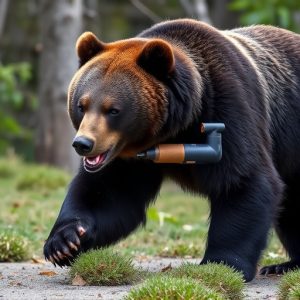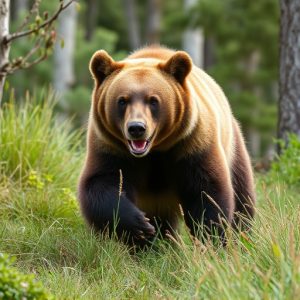Bear Spray: Maximizing Distance, Ensuring Safety
Bear spray, a key safety tool for outdoor enthusiasts in bear country, uses capsaicin from chili pep…….
Bear spray, a key safety tool for outdoor enthusiasts in bear country, uses capsaicin from chili peppers to irritate bears' senses. Effective up to 30 feet, it aids retreat or deterrence. Choosing a device with good maximum distance coverage (20-35 feet), wide patterns, and durable design is vital. Proper aiming at 20-30 feet and avoiding mistakes enhance spray effectiveness. Understanding legalities and practicing in safe environments before real encounters is crucial.
Staying safe while exploring outdoor spaces is paramount, especially with the risk of bear encounters. This guide delves into bear attack prevention spray, a vital tool for hikers and adventurers. We explore ‘bear spray maximum distance coverage’ and key features to ensure its effectiveness. From understanding how it works to legal considerations, this article covers all you need to know to use this game-changer safely and responsibly, enhancing your outdoor experience.
- Understanding Bear Spray: How It Works and Its Effectiveness
- Key Features to Consider in Bear Spray Devices
- Optimal Application Techniques for Maximum Distance Coverage
- Legal and Safety Considerations for Bear Spray Use
Understanding Bear Spray: How It Works and Its Effectiveness
Bear spray, also known as bear deterrent spray, is a crucial tool for outdoor enthusiasts navigating bear country. It’s not just a last-resort defense; understanding how it works and its effectiveness can significantly enhance safety in potential bear encounters. This aerosolized liquid contains capsaicin, the active ingredient found in chili peppers, which irritates bears’ eyes, nose, and respiratory system. When sprayed, it creates a cloud that can provide maximum distance coverage of up to 30 feet, giving users valuable time to retreat or deter an approaching bear.
While no single method guarantees complete protection against bear attacks, research indicates that when used correctly, bear spray has shown remarkable effectiveness. It’s particularly useful in close-quarters situations where other deterrents might not be effective. Proper usage involves aiming the spray at the bear’s face and eyes while backing away slowly. This strategy interrupts the bear’s behavior pattern, often causing it to retreat. However, success depends on factors like the bear’s temperament, distance, and wind conditions, emphasizing the need for proper training and awareness when venturing into areas known for bear activity.
Key Features to Consider in Bear Spray Devices
When selecting a bear spray device, several key features determine its effectiveness and suitability for your needs. One of the most crucial aspects is the maximum distance coverage it offers. This measures how far the spray can reach, ensuring protection from bears at various distances. High-quality devices typically provide a range between 20 to 35 feet (6 to 10 meters), giving users a safe buffer zone during encounters.
Another essential consideration is the spray pattern and distribution. Look for devices with a wide, even spray pattern that covers a significant area. This feature ensures that bears are thoroughly saturated with the deterrent spray, reducing the chance of an attack. Additionally, check for canisters with a durable design and a simple, reliable activation mechanism, as these contribute to the overall reliability and ease of use in stressful situations.
Optimal Application Techniques for Maximum Distance Coverage
When using an outdoor bear attack prevention spray, understanding optimal application techniques is key to ensuring maximum distance coverage. For best results, users should aim directly at the bear’s face and eyes from a distance of 20-30 feet (6-9 meters). This angle and proximity are crucial as they allow for direct inhalation of the spray, maximizing its effectiveness.
A common mistake is to hold the can too close or point it downwards, which can result in less than optimal bear spray distribution. The mist should be aimed upwards at a slight angle to ensure it reaches the bear’s face, covering a wider area with each spray. Regular practice and training can help users develop a steady hand and improve their application technique, ultimately enhancing their safety during potential bear encounters.
Legal and Safety Considerations for Bear Spray Use
Using bear spray is a popular and effective method for preventing attacks, but it comes with legal and safety considerations. The first thing to understand is that regulations surrounding bear spray vary by region. Some areas have strict rules on who can carry it, where it can be used, and even what type of spray is permitted. Always check local laws before purchasing or using bear spray.
Additionally, knowing the maximum distance coverage of bear spray is crucial for safety. Bear sprays typically offer protection up to 30 feet (9 meters), but this can vary based on factors like wind, terrain, and the specific product’s effectiveness. Users should be trained in how to deploy the spray properly and practice in safe environments to ensure they understand its range and effectiveness when facing an actual bear encounter.
Bear spray is a valuable tool for outdoor enthusiasts navigating bear-inhabited areas, offering an effective means of deterring attacks. By understanding its mechanism, choosing the right device, and mastering application techniques, users can maximize its range and ensure personal safety in potential encounters. However, it’s crucial to stay informed about local regulations and practice responsible usage to contribute to the overall safety of both individuals and wildlife.


